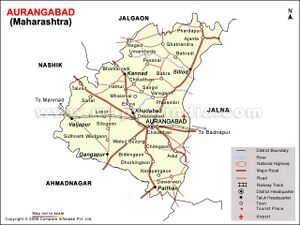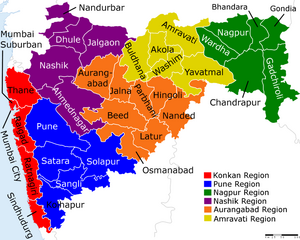Tagara
| Author:Laxman Burdak, IFS (R) |


Tagara (तगारा) was an ancient village in Aurangabad district of Maharashtra state, India.
Origin
Variants
- Tagara (तगारा) (जिला औरंगाबाद, महा.) (AS, p.389)
- Tagarnagar
Jat clans
Mention by Panini
Tagara (तगर) is mentioned by Panini in Ashtadhyayi. [1]
History
Note: Following content is from History And Legend In Hyderabad, pp.7-8
[p.7]:More people have heard of Ajanta and Ellora than of Aurangabad. But the story of this historic district on the Bombay border is almost as interesting as these famous masterpieces in art and architecture.
The earliest trace of human habitation in this district was discovered in the shape of a paleolithic artifact at Moongi on the left bank of the Godavari. Antiquities of the Stone Age, have been discovered at several places in the district but the regular history begins circa 300 B.C., that is, at the beginning of the early Andhra period. Since then man’s genius has continuously exerted itself in fathoming the deepest recesses of the human soul.
These sublime efforts have manifested themselves in monuments at various places, which are permeated with a spiritual glow.
The Pandavas during their exile are said to have wandered into the Aurangabad district, and also to have constructed the massive hill fortification of Deogarh (Deogiri, Devagiri).
The Surpanath hill near Kannad in the district is pointed out as having been the residence of Surpanakha whose ears and nose were cut off by Sri Lakshmana.
The expedition of Alexander made the Greeks acquainted with India and soon they also found the sea route. In those days the Dakshinapatha (Deccan) was under great vassals (Mahamandalesvaras), and hereditary land-holders (Poligars), who owed allegiance to the overlords of Tagara and Plithana (Paithan).
Ptolemy Philadelphus, king of Egypt, sent Dionysius into the southern parts of India about B.C. 268, and it was then that Tagara became known to the Greeks. It is also mentioned by Arrian that on the arrival of the Greeks in the Deccan “ Tagara was the metropolis of a large district called Ariaca, and that Tagara and Plithana were the principal marts in Dachanabades.” All kinds of merchandise from throughout the Deccan were brought to Tagara and thence conveyed on carts to Barygaza, now Broach. Ptolemy agrees with Arrian in placing Tagara and Plithana to the north of Godavari, but the
[p.8]: position of Tagara has not been quite identified, although attempts have been made to fix it near Daulatabad (Deogarh), Bhir, Junagar and Gulbarga.
Plithana is evidently Paithan, as it was about twenty days journey from, or 230 miles south of Broach; and if Ptolemy’s latitude and longitude be correct, Tagara should be 87 miles north-east of Paithan, or near Maiker in Berar.
The more general statements of Arrian and Ptolemy, however, place Tagara ten days’ Journey east of Paithan, which would bring it near Nanded on the Godavari. The remark in the Periplus that coarse dangaris, and very much fine linen, and muslins of sorts, and mallow coloured stuffs, and other merchandise were taken to Tagara from "parts along the coast," would seem to show that Tagara was also in connection with the Bay of Bengal; and it is known that even as early as the time of Sakya Muni, Kalinga on the east coast was noted for the manufacture of fine muslins.
According to Damodar Kosambi, the real name of Junnar may have been Tagara.In his opinion,the name Junnar may be the contracted form of Junapura (Old city).[2] Junnar (जुन्नार) is a city in the Pune district of Maharashtra.
One of the many titles used by the Shilaharas was Tagarapuravaradhisvara, supreme sovereign ruler of Tagara.
तगारा
विजयेन्द्र कुमार माथुर[3] ने लेख किया है ...तगारा (AS, p.389) औरंगाबाद ज़िला, महाराष्ट्र में स्थित था। यूनानी इतिहासकार एरियन के अनुसार तगारा 'इरियाका' नामक ज़िले का मुख्य स्थान था। उस समय तगारा और 'प्लिथान' (या पैठान) दक्षिण भारत की मुख्य व्यापारिक मंडियाँ थीं। दक्षिण के सब भागों का व्यापारिक सामान तगारा में ही लाया जाता था और फिर वहाँ से 'वेरीगाजा' (या भृगुकच्छ या भड़ौच) के बंदरगाह को गाड़ियों द्वारा भेजा जाता था। भौगोलविद् टॉलमी ने तगारस और प्लिथान दोनों को गोदावरी नदी के उत्तर में स्थित बताया है। प्लिथान तो अवश्य ही पैठान या प्राचीन प्रतिष्ठान है। तगारा का अभिज्ञान अभी तक ठीक-ठीक नहीं हो सका है। एरियन और टॉलमी ने यह भी लिखा है कि तगारा, पैठान से 10 दिन की यात्रा के पश्चात् पूर्व में मिलता था और पेरिप्लस के अनुसार तगारा की मंडी में अन्य वस्तुओं के अतिरिक्त समुद्र तट से अति सुन्दर तथा बारीक कपड़ा मलमल आदि भी आता था। उपर्युक्त तथ्य से यह जान पड़ता है कि यह स्थान गोदावरी पर स्थित नंदेड़ के समीप होगा और इसका व्यापारिक संबंध कलिंग देश से रहा होगा, जहाँ का बरीक कपड़ा बौद्ध काल में काफ़ी प्रसिद्ध था। (दे. तेर)

